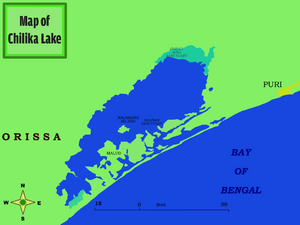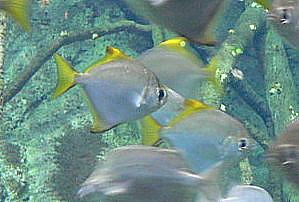Brackish water facts for kids
Brackish water is a mix of salt water and fresh water. It's saltier than fresh water, but not as salty as the ocean. You can find it where rivers meet the sea, like in estuaries. It can also be found in underground water sources called aquifers.
Sometimes, people create brackish water through projects like building dikes or flooding coastal areas to make pools for freshwater prawns.
Technically, brackish water has between 0.5 and 30 grams of salt per litre. This is often called 0.5 to 30 parts per thousand (ppt). So, "brackish" covers a wide range of saltiness and isn't just one exact level. The saltiness of brackish water can change a lot depending on the place or time.
| Water Salinity Levels (Salt per 1000 parts of water) | |||
|---|---|---|---|
| Fresh water | Brackish water | Salty water | Brine |
| Less than 0.5 ppt | 0.5 to 35 ppt | 35 to 50 ppt | More than 50 ppt |
Contents
What Does "Brackish" Mean?
The word "brackish" comes from the Low German word Brack. This word describes a small lake that forms when a big storm tide breaks through a dike and floods the land behind it.
Where Can You Find Brackish Water?
Brackish water creates unique homes for many plants and animals. Here are some of the most important places where you can find it:
Estuaries: Where Rivers Meet the Sea
The most common brackish water habitats are estuaries. An estuary is a special place where a river flows into the sea, mixing fresh river water with salty ocean water. A famous example is the Thames River in London, England.
Mangrove Swamps
Another important brackish water habitat is the mangrove swamp, also known as a mangal. These are forests that grow in coastal areas where fresh and salt water mix.
Brackish Seas and Lakes
Some large bodies of water, like certain seas and lakes, are also brackish.
- The Baltic Sea is a brackish sea located next to the North Sea. It's the largest body of brackish water in the world!
- The Caspian Sea is the world's largest lake. Its water is brackish, with about one-third the saltiness of regular seawater. The Caspian Sea is famous for its unique animals, including the Caspian seal (one of the few seals that doesn't live in the ocean) and large sturgeon fish, which are known for their caviar.
Important Brackish Water Places

Here are some well-known brackish water locations around the world:
Brackish Seas
- Baltic Sea (the world’s largest brackish water body)
- Black Sea
- Caspian Sea (the world’s largest lake)
Brackish Lakes
- Lake Charles in Louisiana, USA
- Chilika Lake in Odisha, India
- Pangong Tso (Lake) in Ladakh, Jammu and Kashmir, India
- Lake Van in Turkey
Coastal Lagoons, Marshes, and Deltas
- The Burgas Lakes near the Bulgarian Black Sea Coast
- Kaliveli Lake near Pondichery, India
- Kerala Backwaters, a series of lagoons and lakes in Kerala, India
- Lagos Lagoon in Lagos, Nigeria
- Lake Pontchartrain, north of New Orleans, Louisiana, USA
- Pulicat Lake, north of Chennai, India
- The Rann of Kutch, on the border of India and Pakistan
- Parts of the Rhône River Delta in France, known as the Camargue
Estuaries
- Amazon River: This huge river empties so much fresh water into the Atlantic Ocean that it makes the sea less salty for hundreds of miles.
- Chesapeake Bay in Maryland, USA
- The Fleet lagoon in Dorset, England
- Hampton Roads in Virginia, USA
- Lower Hudson River in New York and New Jersey, USA
- Lingding Yang in Guangdong, People's Republic of China
- Port Royal Sound in Beaufort County, South Carolina, USA
- Saint Lawrence and Saguenay Rivers, downstream from Québec and Saguenay respectively.
- The Thames Estuary in South East England
See also
 In Spanish: Agua salobre para niños
In Spanish: Agua salobre para niños



